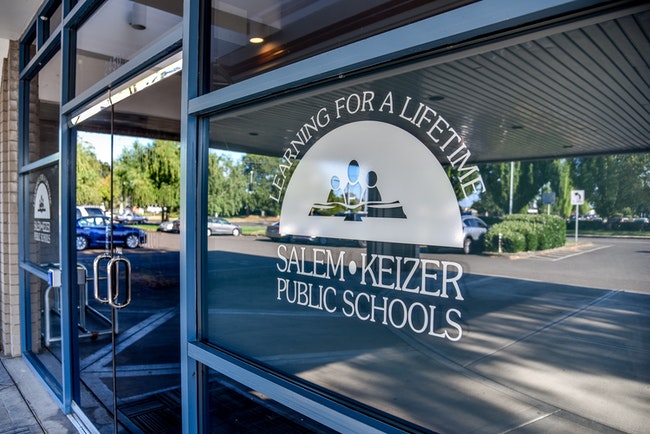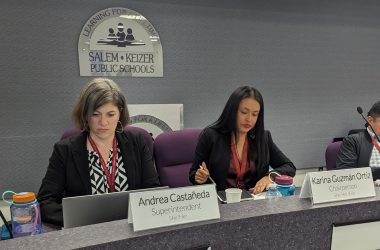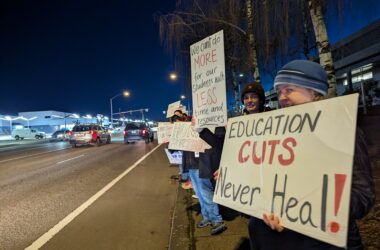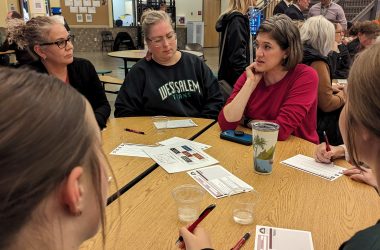
More than 4,600 Salem-Keizer high school students – about 39% of the total – failed at least one class during the second and third quarters of the school year.
That’s slightly worse than the first quarter, when about one in three students failed at least one course.
And for all grades given out to high school students, about 20% were Fs in the third quarter, which runs from February to April.
That number was 10% during first semester of the 2019-20 school year. That’s the most recent comparable quarter before Gov. Kate Brown shuttered schools across Oregon in response to Covid.
The data, obtained by Salem Reporter, show student academic performance didn’t improve through the year while local schools remained online in the winter and spring.
That’s despite local high schools bringing in hundreds of struggling students weekly for two-hour personal tutoring sessions and mobilizing counselors and outreach workers to call and visit the homes of students who weren’t signing into their online classes.
There were large racial disparities in failing grades, with Latino and Pacific Islander students much more likely to fail courses.
Grades for fourth quarter will be out after the school year ends June 17. Those grades will be the first since the Covid pandemic began where all Salem-Keizer students could attend some classes in person, though generally limited to two days a week.
The share of failing grades varied by high school, and some schools recorded slightly better results from fall to spring. But even that improvement still left more students with failing grades with online school than before the pandemic.
While letter grades don’t capture everything about what a student learned, they’re one of the few indicators of high school students’ performance.
That’s especially true this spring as the Salem-Keizer School Board narrowly voted in April to allow the district to skip state standardized tests.
A higher share of failing grades also means more students won’t get credit for courses they need to graduate high school.
(Graphic by Rachel Alexander/Salem Reporter)
Iton Udosenata, assistant superintendent for secondary instruction, said he couldn’t identify a specific reason why the district’s F rate remained so high aside from the overall challenges of online school.
“It’s really hard to drill down to identify why there hasn’t been a change,” he said.
He said other school district leaders across Oregon tell him they also are seeing far more Fs in winter and spring than in the fall.
In the second and third quarters, nearly half of Latino and two in three Pacific Islander high school students failed at least one course. That’s compared to about 19% of Asian students, 29% of white students and 39% of all high schoolers posting at least one F during third quarter.
The district’s Enhanced Digital and Guided Education program, commonly called EDGE, recorded one of the highest rates of Fs in the district. The program was created this year as an all-online option for families who knew they didn’t want to resume in-person school regardless of pandemic rules.
About 28% of EDGE high school grades were Fs during third quarter. Only North Salem High School had a higher share, 31%.
The EDGE program will remain an option for students next school year. District administrators said it’s intended to serve students who work well with online classes, and those who would benefit from a more flexible class schedule.
Udosenata said EDGE administrators and counselors will reach out to families and examine school data more closely over the summer to identify improvements.
Udosenata said district leaders are focused on assessing students and planning for a much larger summer school program to help them recover. Many students have already made up failed classes through credit recovery programs, he said, though he didn’t have specific figures.
In the fall, Udosenata said the district will hire nine math coaches for middle school students and nine high school coaches to focus on either math or another core academic subject where students struggled. That’s intended to bring along students who are still behind academically after the summer. Udosenata said the district is using federal coronavirus relief money to pay for the positions.
Schools will also expand before and after school programs to help struggling students.
Jaleel Kindell, a community resource specialist who works one-on-one with struggling students, said he’s seen improvements since in-person classes resumed.
“It makes our jobs a lot easier because we’re able to go to these schools and I’m able to see 10 kids at a time,” he said.
Previously school outreach workers had to go to students’ homes one by one to check in when other methods failed. Fears of contracting Covid made that more difficult.
“A lot of parents didn’t want us in their homes and people weren’t answering doors and phones,” Kindell said.
Kindell and Udosenata said they’re seeing more students and families interested in summer school because they want to catch up and be around their peers after a year of mostly online classes.
“Prior to this when it came to summer school, people kind of ran from it. Now we’re getting people coming out of nowhere asking about the summer school opportunities,” Kindell said.
Contact reporter Rachel Alexander: [email protected] or 503-575-1241.
JUST THE FACTS, FOR SALEM – We report on your community with care and depth, fairness and accuracy. Get local news that matters to you. Subscribe to Salem Reporter starting at $5 a month. Click I want to subscribe!

Rachel Alexander is Salem Reporter’s managing editor. She joined Salem Reporter when it was founded in 2018 and covers city news, education, nonprofits and a little bit of everything else. She’s been a journalist in Oregon and Washington for a decade. Outside of work, she’s a skater and board member with Salem’s Cherry City Roller Derby and can often be found with her nose buried in a book.









